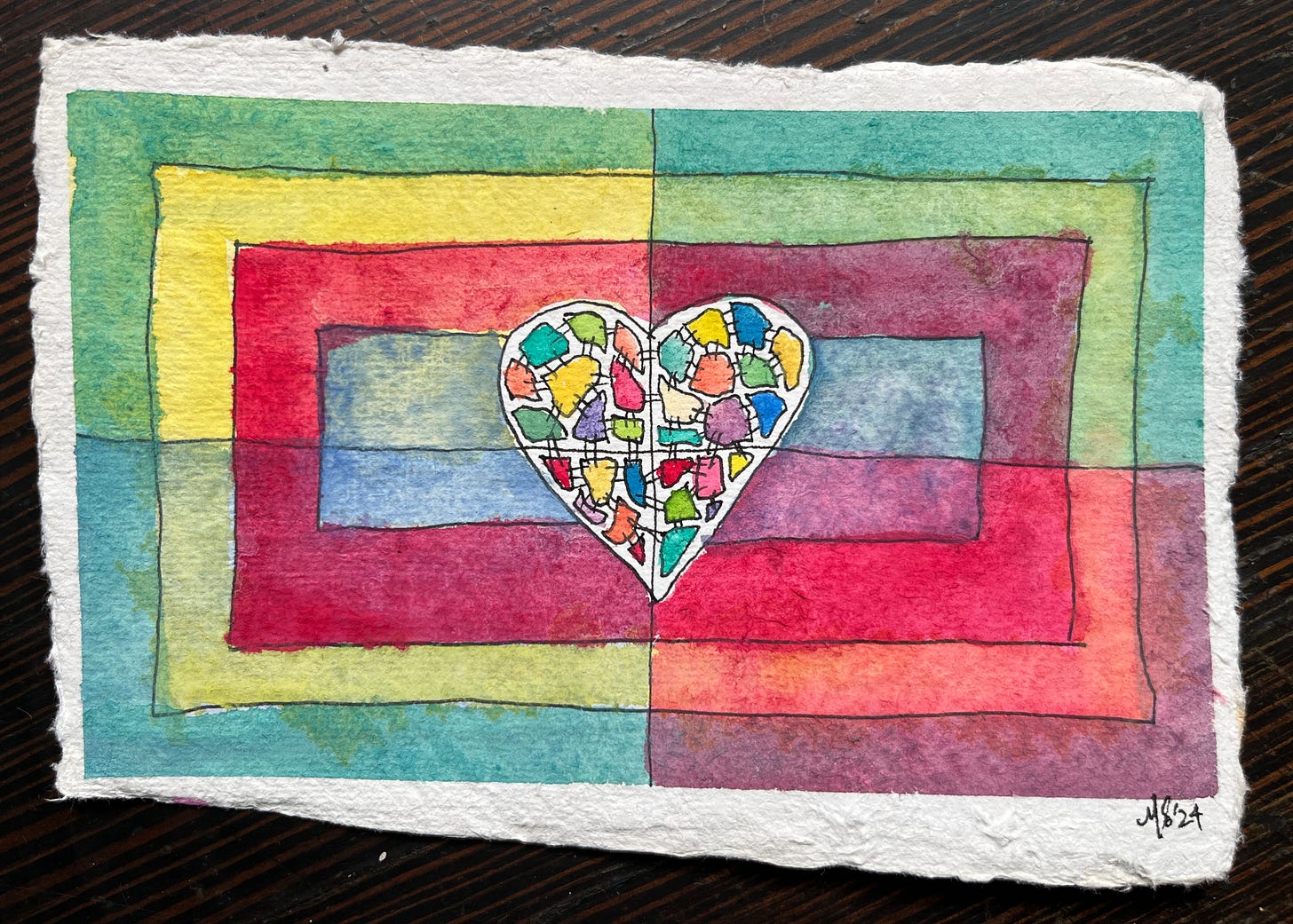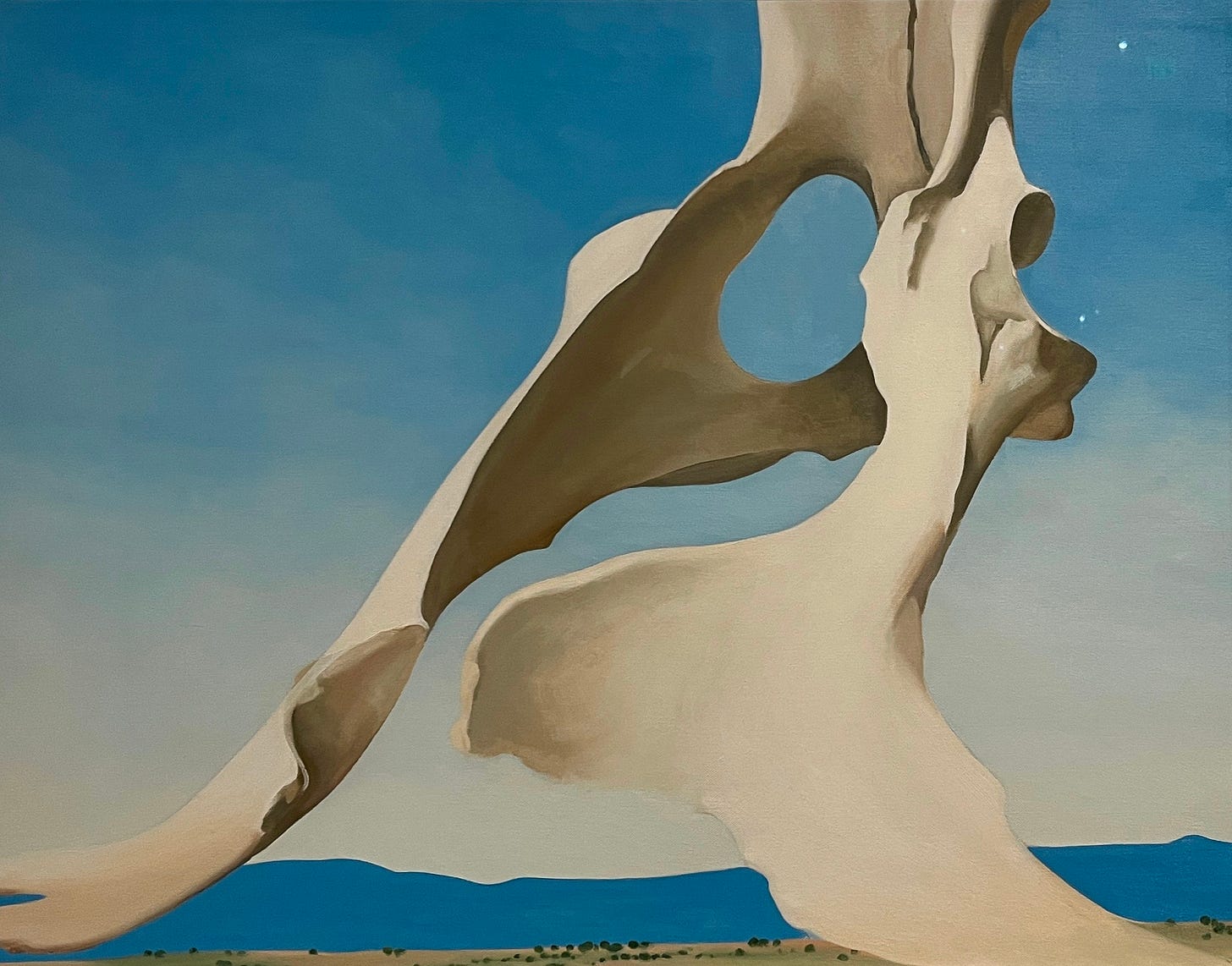Art has been my solace and fuel since the election. There was the antiquarian book show, where we witnessed the longevity of the written word. And a Georgia O’Keefe - Charles Moore exhibition at the Boston Museum of Fine Arts. O’Keefe, whose work I’ve loved since I was a child, was “most interested in the holes in the bones—what I saw through them—particularly the blue from holding them up against the sky…they were most wonderful against the Blue—that Blue that will always be there as it is now after all man’s destruction is finished.” A perfect thought for this particular moment of beauty and terror.
The beauty I saw in books and on canvas that weekend after the election has inspired me. I’ve creaked open the craft box my parents bought me in sixth grade to see what I might find, discovered an old watercolor set and half-finished postcards. I’ve been playing around with the liquid colors. My mind melts in a delicious way that is so different than when I’m wrestling with the written word.
But words still dominate the creative space in my mind. It was delight to share space with other writers in the Off Assignment Master’s Series class Writing this Warming World that I taught last month. It was the best of what the internet can be. Writers logging in from all over the US, from late-night India, and first-light New Zealand. All to share our ideas about how to respond with words to this moment. (Beauty! Terror!) And the guest authors, one each week, were so generous with their time and thoughts. I wanted to pass along some of the brilliance they shared:
Emily Raboteau reminded us that personal stakes and vulnerability have to be on the page, and she passed along writing advise that she once received (because we are all runners in this writers’ relay race, aren’t we?): keep a notebook on you always and write down what surprises you, what frightens you, what makes you laugh.
Elizabeth Rush Zoomed in from Colombia, where she’s on a sabbatical year. She stressed the importance of not writing something if you already know how the story will end. Keep the tension engine going and let the reader join you in your discovery. Advocate but hold your arms open. Sometimes, reel in the rage. Always, take time for long walks.
J. Drew Lanham said he returns again and again to the Three R’s when he’s writing: recognition, reconciliation and reparation. Empathy is always his thread. Trust your heart, he told us. Trust the reader.
Helen Macdonald came to us from the UK and advised us to bring passion and a loving eye to the science of the world, to allow yourself to “unself” as you envision the vantage of—say—a kestrel. They also shared the excitement of watching the filming underway for H is for Hawk, which I cannot wait to see!
Off Assignment has a steady stream of great courses, including upcoming The Business of Freelancing with Ali Francis and Writing Motherhood with Rachel Yoder, (Check out all the class possibilities here.)
¡Voy a España!
I’ll be packing up my watercolors and a stack of books on renewable energy as I head to Spain next month. I’m elated to have received a grant from the FRONTIERS Science Journalism in Residency Programme, an initiative of the European Research Council Along with nine other journalists from around Europe, I’ll be part of the second cohort of grant recipients, based across Europe. I’ll be at the Basque Center for Climate Change (BC3) in Bilbao, which takes a multi-disciplinary approach to understanding the causes and consequences of climate change. My research question: can the clean energy transition work better for biodiversity, people and place?
Transitioning to clean energy is urgently needed to even begin to meet the climate crisis but implementing renewable energy projects is too often seen as a technological problem alone. In order to succeed, wind and solar projects have to address local concerns—ecological, cultural and economic—or risk public backlash that threatens to derail efforts. I realized this while standing with South Indian farmers who’d lost their land to a solar farm the size of Manhattan, reporting for a recent New Yorker feature, and as I watch the opposition to offshore wind grow where I live on Cape Cod. But I saw a hint of a way that projects could do better in the south of Spain a couple of years ago, as I watched wind technicians, like the one I photographed above, look for migrating raptors and shut down wind turbines so they could safely pass. Catrin Einhorn of The New York Times recently reported on how solar sites can nurture native flora and fauna. There are ways to do this better. And these controversial projects must get it right from the start. Turbines that don’t kill birds. Solar that doesn’t steal agricultural land and disproportionately hurt women. Power that is affordable. Is it possible?
If you know of researchers, fellow journalists, academics or projects that might be of interest as I pursue this work, please message me!
And then some…
And in case you missed it, I hope you’ll take a few moments to read A Measure of Gratitude, a deeply personal piece I wrote about a friendship and organ donation for the Virginia Quarterly Review.
“My lord, this story,” commented Patton Dood on Facebook. “It's about the effort of giving something away and expecting nothing in return -- ‘effort’ being the key term, because while stories of grace abound, they tend to be sentimental, and therefore dishonest. This one is anything but.” Thanks, Patton, and all those who have sent me kind words. <3
Also, for the science journalists out there, applications are now open for two great fellowships: the Logan Science Journalism Program fellowship offers a chance to get immersed for ten days in basic biomedical or environmental research at the Marine Biological Lab in Woods Hole, MA. And the Knight Science Journalism fellowship grants a precious full year at MIT in Cambridge, MA. I’ve been lucky to do both and learned so much through them along with making great connections to other journalists that have lasted to this day. I found out about the FRONTIERS fellowship, for example, through the good folks at KSJ.
Take note…
Nature reports that Swiss lawyer Cordelia Bähr, who represented 2,500-plus women in a landmark climate lawsuit, won a case that argued that climate change violated the human rights of older women. Her argument was based on the fact that older women died at higher rates during the 2003 European heatwave.
Youth climate activists grow up…and into their power, switching strategies as they mature and in response to a world that will, once again, break an annual heat record. Here’s Austyn Gaffney’s piece in The New York Times on the new strategies some are enacting as we head into a second Trump administration.
"We invent rituals to shield ourselves: wear this, shout that,” writes Erica Berry in her book Wolfish, a brilliant exploration of fear, the myths and the realities, in the worlds of wolves and women. “The systems become our stories. The stories become our lives." I am deeply enojoying her nuance and exploration.
And for the perfect parting shot, look no further than Nature’s selection of the best science images of the year to remember that we share the planet with volcanoes that breathe, trees cloaked with monarchs, and sea turtles that offer a place to land. And the planet hovers in a great big universe of shooting stars and eclipses, and if you look into a microscope, there are other worlds unfolding. May the gift of the season be the gift of all this life, abounding around us.
Be well.
Be kind.
~Meera








